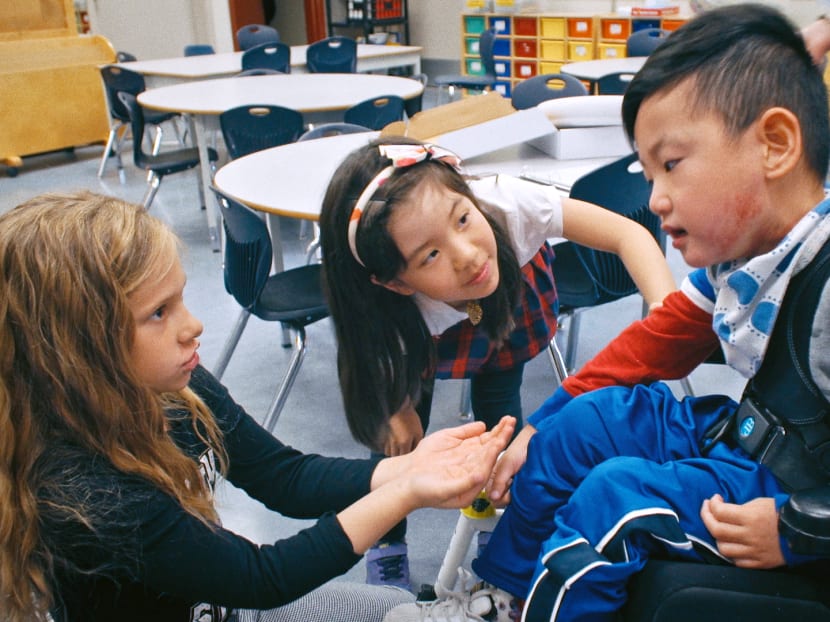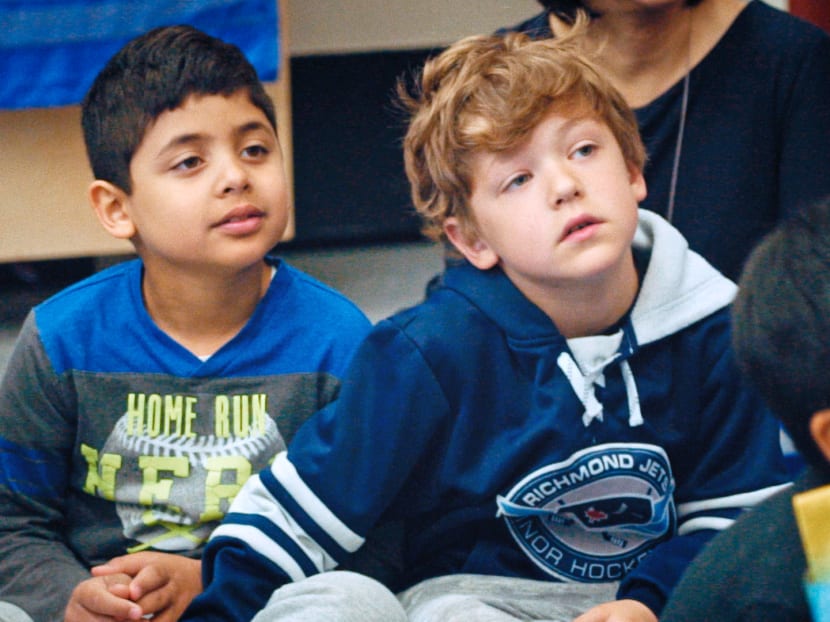The Big Read in Short: Inclusive education, British Columbia-style — can S’pore take a leaf from it?
Each week, TODAY’s long-running Big Read series delves into the trends and issues that matter. This week, we look at how a Canadian province has made it possible for children with or without special needs to study and play together. This is a shortened version of the full feature.

Eight-year-old Joshua (right) with his classmates Mia and Chanelle from Ferris Elementary School. Joshua has Pura syndrome, a neurodevelopmental disorder.
Each week, TODAY’s long-running Big Read series delves into the trends and issues that matter. This week, we look at how a Canadian province has made it possible for children with or without special needs to study and play together. This is a shortened version of the full feature, which can be found here.
VANCOUVER/SINGAPORE — A student with Fetal alcohol spectrum disorder (FASD) stood in front of his class, explaining his condition — which is characterised by behavioural and physical problems such as a smaller head, hyperactivity and learning disabilities — with the support of his teachers and parents.
To do that, he and his classmates drew pictures of brains, and talked about how everyone’s brain was different.
Such “demystification sessions” are a regular feature at Ferris Elementary School in Vancouver, which takes in both children with and without special needs.
Such sessions are among the many examples of inclusive practices that schools in British Columbia — Canada’s westernmost province — have adopted to support and integrate children with special needs.
The province includes the city of Vancouver and has a population of almost 5 million.
About two decades ago, public special education schools were progressively phased out in British Columbia and special education teachers were redeployed to work at the district level, helping schools with the transition to inclusion.
In 1995, a Special Education Policy Framework for British Columbia was also established, which served to guide the development of legislation for special education programmes and services in British Columbia.
Such frameworks and fierce advocacy by parents of children with special needs have helped to ensure that this group gets a shot at normal school life — not just playing but learning alongside their peers according to their abilities.
Amid the push towards a more inclusive society in Singapore — which includes greater inclusion in schools — TODAY, in partnership with philanthropic organisation Lien Foundation, visited Vancouver for a week earlier this year to get a first-hand look at how schools there have made inclusion a reality.
.embed-container { position: relative; padding-bottom: 56.25%; height: 0; overflow: hidden; max-width: 100%; } .embed-container iframe, .embed-container object, .embed-container embed { position: absolute; top: 0; left: 0; width: 100%; height: 100%; }S’PORE’S EFFORTS
In Singapore, a similar movement is taking shape: The Government has made strides towards a more inclusive education in recent years, amid calls by Members of Parliament (MPs), organisations and parents of those with special needs.
In April, a workgroup was set up by the Ministry of Social and Family Development (MSF) to look at how to better integrate children with learning needs into pre-schools.
While inclusive preschools, such as Kindle Garden and Sail Playhouse, have started operating in recent years, they still form a minority in the preschool sector..
Starting this year, it also became compulsory for children with moderate to severe special needs to attend school under the Compulsory Education Act — unless they apply for an exemption.
Prior to the change, children with moderate to severe special needs are exempt from compulsory education.
Although there is now more momentum behind improving inclusion in schools, turning theory into practice can often be the hardest part.
TAKEAWAYS FROM BRITISH COLUMBIA
To that end, Singapore could take a leaf from British Columbia, a province in Canada, in several ways:
-
CONTINUOUS SUPPORT STRUCTURES, CUSTOMISED LEARNING
Elementary schools there have in place continuous support structures to help children with special needs, with allied professionals such as speech and occupational therapists providing support within the mainstream school setting itself.
This is partly because most public elementary schools in British Columbia enrol children from Kindergarten 1 through to Grade 7 (age 5 to 12).
In addition, the Special Education Policy Framework also gives teeth to educators and parents who wish to see more inclusive practices in classrooms.
Under the Policy Framework, each child with special needs has the right to an individual education plan (IEP), which provides the foundation for an alternate educational pathway according to their needs.
If they are not able to graduate by taking the provincial exams, they receive a certificate recognising their achievements according to their IEPs, reducing the “fall out” or “drop out” rate of those with special needs from the mainstream system.
-
KEY ROLE OF ALLIED EDUCATORS
Another key factor in making inclusion a reality in mainstream schools is the availability and capabilities of allied educators.
These assistants not only support students with special needs, but also take some pressure off classroom teachers who are teaching curriculum.
In British Columbia, education assistants are the equivalent of learning and behavioural support allied educators in Singapore — they cooperate with classroom teachers to provide support for students with special needs.
In British Columbia, there are currently about 73,000 students with special needs, with close to 12,000 education assistants.
In Singapore, there are more than 25,000 students with special needs in mainstream schools here, and about 500 AEDs (LBS), said the Ministry of Education (MOE).
-
PROSPECTS FOR SPECIAL NEEDS EDUCATORS
While British Columbia — like Singapore — still grapples with the problem of attracting and retaining allied educators due to the long working hours and relatively poor salary, the opportunity for education assistants to improve their prospects in the Canadian province has encouraged some to continue.
Among other things, unions which protect the rights of workers such as education assistants have allocated more funds to support their skills development in recent years.
In addition, certified education assistants in British Columbia are put through at least two practicums.
Some polytechnics there also require applicants to first have two years of college study or to have done 100 hours of volunteering with children before accepting them into the course.
These baseline qualifications provide certified education assistants a good launchpad to further their careers. With additional training, they are able to transition into more challenging roles, such as becoming sign language therapists, or even classroom teachers.
-
MORE INTERACTION, CO-LEARNING
Schools in British Columbia also actively encourage interaction among those with and without special needs, either through demystification sessions, or co-learning in the same classroom.
For example, in Math class, 7-year-old Ahmed, a boy with autism, participates in classroom activities by completing tasks such as grouping and tallying number with two of his peers.

Through frequent interactions, those without special needs also gain a deeper understanding of different conditions, cultivating empathy and acceptance.
Grade 2 students at Ferris Elementary, Chanelle and Mia Yang, for example, learnt how to help and communicate with their classmate Joshua, who has Pura syndrome (a neurodevelopmental disorder).
Chanelle said: “We learnt that if we sing a song like Baby Shark, if he faces towards us and crawls, that means he wants (our) attention… we (can) try to help Joshua with his daily physical activity by pushing him on the track... and we can use his (bib) to wipe his drool.”
NO ‘PERFECT SYSTEM’ FOR INCLUSIVE EDUCATION
Jalan Besar GRC MP Denise Phua, is a fierce advocate for inclusive education in Singapore.
While she cautioned against “blindly following” another school system, Ms Phua — who was not part of the trip organised by the Lien Foundation — called for a “local system that adopts the best of both mainstream and special education”.
Ms Phua, who co-founded Pathlight School, noted the spectrum of special needs and the education culture in Singapore which still emphasises academic results in some ways.
Nevertheless, Ms Phua, who chairs the Government Parliamentary Committee for Education, agreed that an inclusive system must have features such as an IEP, trained allied educators, as well as availability of education psychologists and other specialists such as occupational and speech therapists.









